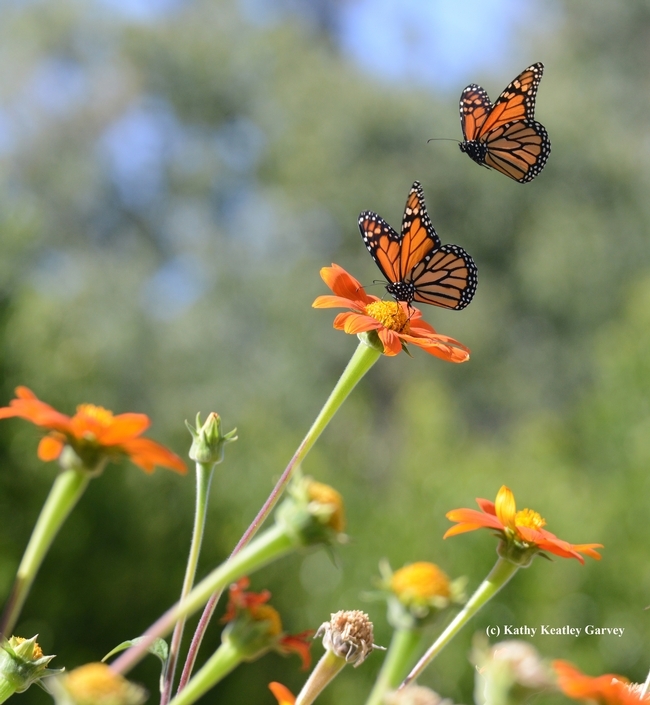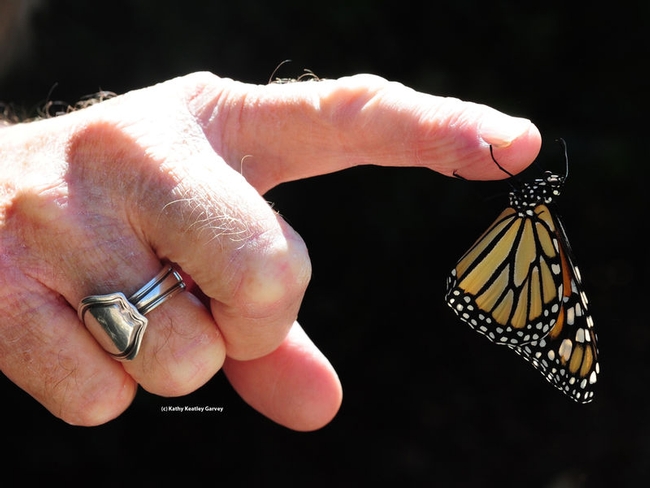It's good to see butterflies, especially monarchs, getting so much press.
Now let's see if we can press the issue.
The Washington Post just published an article in its style section: "Butterflies Were Symbols of Rebirth. Then They Started Disappearing," chronicling the history--as we know it--of butterflies. For his in-depth piece, reporter Dan Zak interviewed butterfly guru Art Shapiro, distinguished professor of evolution and ecology at UC Davis, who has monitored the butterfly population in Central California since 1972 and maintains a research website.
The Washington Post reporter mentioned the monarch butterfly summit held Feb. 28 in the Putah Creek Lodge, UC Davis, where invited guests of the Environmental Defense Fund discussed "Recovering the Western Monarch Butterfly Population: Identifying Opportunities for Scaling Monarch Habitat in California's Central Valley."
How serious is it? "The latest population surveys indicate that monarchs overwintering on the central coast have declined 86% since last winter and now total 0.5% of their historical average," according to the agenda.
Shapiro, one of the speakers, delivered a presentation on "What We Don't Know and What We Know That Ain't So About Monarchs" in which he declared that "monarchs are on life support in California, and we are reduced to prescribing placebos." (See Bug Squad blog.) "I never saw a single wild Monarch larva in 2018—the first time since I became butterfly-aware in 4th or 5th grade!" he said.
In his Washington Post piece, published March 6, Zak wrote: "There's compelling evidence that pesticides, deforestation and habitat loss are to blame for monarch decline. Climate change sharpens every threat by altering weather patterns, extending droughts, strengthening storms. It's easy to conclude, then, that we are responsible....Shapiro says we don't fully understand what's happening to butterflies, but he can't shake a feeling of responsibility."
“I feel like a doctor who has a patient he's known his entire life, and the patient is obviously dying, and the doctor and his colleagues have been unable to determine why — so they can't recommend treatments,” Shapiro told the reporter. “It's a level of frustration where I'm watching things that I love go away, and there's nothing I can do about it but just stand there.”
We experienced that a little of that level of frustration last year in our pollinator garden in Vacaville. We saw--and reared--only 10 caterpillars in 2018. Compare that to 2016 when we reared and released more than 60 monarchs.
In 2016, we'd commonly see seven or eight at any given time all day long in the late summer and early fall. They'd stop for some flight fuel before winging it over to the California coast to overwinter. On Labor Day, 2016, we photographed a tagged migratory monarch from Ashland, Ore. nectaring in our garden. It was part of a citizen science project conducted by Washington State University entomologist David James.
Very few migratory monarchs fluttered into our garden in 2018. Where are all the monarchs? Something indeed was--and is--happening.
"For thousands of years, humans have looked to butterflies as a reassuring symbol in times of change," Zak wrote. "The Earth now is changing, and butterflies have become a symbol of something else: loss."
As Shapiro said in his presentation in the Putah Creek Lodge:
- Consider a doctor faced with a patient in rapid decline. All tests have failed to identify the cause. What is the doctor to do? You can't prescribe treatment for an undiagnosed illness, can you? You can make a wild stab at a prescription on the basis that the patient is going to die anyway, and MAYBE, just maybe, this drug will do some good. Or you can prescribe a placebo, just to reassure the patient that you are doing something. That's where things get interesting. Occasionally a patient improves drastically on a placebo. Maybe he would have improved anyway; there's no way of knowing. Suppose our patient has a complete remission despite having received only a placebo. Does our doctor convince himself the placebo cured him?
As of right now, the Monarch is on life support in California, and we are reduced to prescribing placebos. If our patient comes back from the brink—as history suggests it may well—will we convince ourselves that our placebos worked? Probably. And that's not how to do science. That's what philosophers call the fallacy of post hoc, ergo propter hoc.
We can do can do better than that!
Meanwhile, Shapiro will be teaching a UC Davis graduate student course, "The Science of the Monarch Butterfly," on Tuesday nights, starting April 2, during the spring quarter. The course is set for 8:10 to 10 p.m. every Tuesday in Room 2342 in Storer Hall, located off Kleiber Hall Drive. He's inviting citizen scientists or others interested in the science of the monarchs to audit the course, for free. No reservations are required.
Attached Images:

